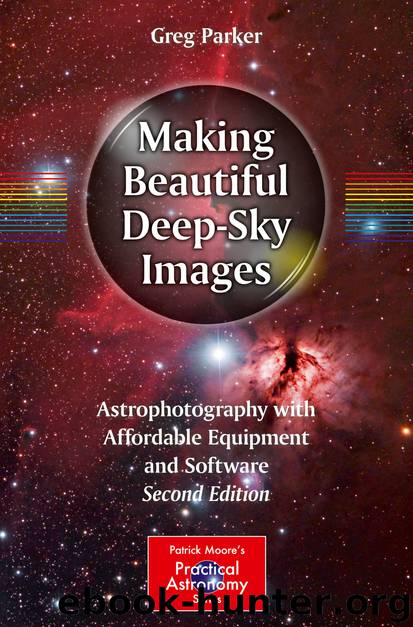Making Beautiful Deep-Sky Images by Greg Parker

Author:Greg Parker
Language: eng
Format: epub
Publisher: Springer International Publishing, Cham
There are several things to note in the CCDInspector result. A large number of stars have been analysed to produce this result (1279), so you can therefore be assured that CCDInspector has returned with some pretty accurate numbers. I haven't gotten the camera precisely flat in the X and Y planes, but it is close enough to zero to be unnoticeable in the final image. The Sky 90/M26C combination gives me around 3 arc-seconds per pixel , so 2.2 pixels for the collimation in the CCDInspector result means around 6 arc-seconds for the collimation. Again, this is small enough to be unnoticeable, but it is always worth the effort, and the time, to do better in setting the camera up at this stage if you can.
You are now ready to start imaging your object for the evening. As you have an autoguider going, then use the "dither " function on your CCD imager software. This moves your mount by a set number of pixels after each sub-exposure so that by using an "outlier rejection" stacking routine on your subs (like SD Mask in Maxim DL) you will get rid of any hot pixel s in the stacking process. With your autoguider running and looking good, then set off the imaging camera with the sub-exposure length you have chosen for the evening. Save the subs as FITS format and to the bit length of your camera. Stop imaging after an hour (if necessary) to refocus the scope, and then carry on. If you have a GEM mount, you may come up to the meridian at some point during your imaging and then you will have to carry out a meridian flip. Consult your planetarium program to check what time your object transits the meridian so you can plan out your imaging session accordingly. There is a HUGE amount to think about just to get a few subs down, and unless you have everything planned out and executed precisely, you won't have much of a fun time. Be prepared to have little fun during your first few sessions, but don't be put off. When you have carried out the meridian flip and have the same guide star centred in your FOV , then be aware the image on your monitor is upside down to what it was pre-meridian flip. Accordingly, don't forget to vertical mirror flip all your post meridian flip images before stacking the whole night's sub-exposures together.
Once you have collected the evening's worth of subs and you are ready to shut down, turn off the autoguider and the CCD imager download program and park your scope. Turn off all systems and take all your hard won subs indoors for the image processing part of the procedure.
Download
This site does not store any files on its server. We only index and link to content provided by other sites. Please contact the content providers to delete copyright contents if any and email us, we'll remove relevant links or contents immediately.
| Computer Vision & Pattern Recognition | Expert Systems |
| Intelligence & Semantics | Machine Theory |
| Natural Language Processing | Neural Networks |
Algorithms of the Intelligent Web by Haralambos Marmanis;Dmitry Babenko(7852)
Hadoop in Practice by Alex Holmes(5660)
Jquery UI in Action : Master the concepts Of Jquery UI: A Step By Step Approach by ANMOL GOYAL(5512)
Life 3.0: Being Human in the Age of Artificial Intelligence by Tegmark Max(4507)
Functional Programming in JavaScript by Mantyla Dan(3723)
The Age of Surveillance Capitalism by Shoshana Zuboff(3422)
Big Data Analysis with Python by Ivan Marin(3009)
Blockchain Basics by Daniel Drescher(2891)
The Rosie Effect by Graeme Simsion(2708)
WordPress Plugin Development Cookbook by Yannick Lefebvre(2602)
Hands-On Machine Learning for Algorithmic Trading by Stefan Jansen(2518)
Applied Predictive Modeling by Max Kuhn & Kjell Johnson(2478)
Dawn of the New Everything by Jaron Lanier(2438)
Test-Driven Development with Java by Alan Mellor(2379)
The Art Of Deception by Kevin Mitnick(2297)
Data Augmentation with Python by Duc Haba(2224)
Rapid Viz: A New Method for the Rapid Visualization of Ideas by Kurt Hanks & Larry Belliston(2195)
Human Dynamics Research in Smart and Connected Communities by Shih-Lung Shaw & Daniel Sui(2178)
The Infinite Retina by Robert Scoble Irena Cronin(2176)
